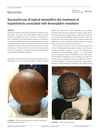Search
for
Did you mean Topical Minoxidil 5%?
Products matching "topical minoxidil 5 foam"
Tracking 2 products like 15 Minoxidil Foam and 31 Minoxidil Foam from by companies like Hims and Keeps. View all 2 products »Learn
5 / 20 resultslearn Minoxidil
An essential vasodilator with some anti-androgenic effects, has excellent safety record
learn Mesotherapy
technique to inject very small amounts of beneficial chemicals into the scalp
learn Spironolactone
powerful topical and oral anti-androgen used mostly by women
learn Clascoterone
a novel topical treatment that inhibits DHT on androgen receptors
Research
5 / 1000+ results
research Efficacy and Safety of 5% Minoxidil Topical Foam in Male Pattern Hair Loss Treatment and Patient Satisfaction
5% minoxidil foam is a safe, effective treatment for male pattern hair loss, with increased hair count and few side effects.

research Pumpkin Seed Oil vs. Minoxidil 5% Topical Foam for the Treatment of Female Pattern Hair Loss: A Randomized Comparative Trial
Pumpkin seed oil slightly outperforms minoxidil foam in treating hair loss with fewer side effects.
research Comparative Study Between the Efficacy and Safety of Topical Sildenafil Citrate Solution and Topical Minoxidil 5% in the Treatment of Female Pattern Hair Loss
Topical minoxidil 5% is better for treating female pattern hair loss than topical sildenafil 1%.

research A Case of Contact Allergic Dermatitis to Topical Minoxidil
A woman had an allergic skin reaction to a hair loss treatment containing minoxidil and should not use it.

research Successful Use of Topical Minoxidil in the Treatment of Hypotrichosis Associated with Desmoplakin Mutations
Topical minoxidil helped an 8-year-old boy with a genetic hair disorder grow hair.
Community Join
5 / 1000+ resultscommunity What kind of pill should i choose?
Treating alopecia androgenetica with limited options, such as spironolacton, dutasteride, finasteride, minoxidil 5%, Rogaine foam for men, a shampoo with ketoconazol, iron supplement and dermarolling.
community 6 month update (1mg fin. 5% min. daily)
The conversation discusses a 6-month hair loss treatment update using 1mg finasteride and 5% minoxidil daily. Some users apply minoxidil once or twice a day, and there's no mention of using a dermaroller or dermastamp in the treatment.
community Have been on treatment for close to two years, need to know if I should continue or take dut
A 22-year-old male has been using finasteride, topical minoxidil, and oral minoxidil for hair loss but sees minimal improvement and is considering adding dutasteride. Users suggest additional treatments like dermarolling, PRP, and consulting a dermatologist, or considering a hair transplant.
community Fibrosing alopecia in a pattern distribution
A user has been experiencing hair loss for 4 years, with treatments like minoxidil, finasteride, and various supplements proving ineffective. They were diagnosed with fibrosing alopecia in a pattern distribution, a condition that may require a combination of anti-inflammatory and hair growth treatments.
community Taking Charge of Your Hair: The "Big 3 Stack" Explained for 2023
The "Big 3 Stack" for hair loss treatment, which includes Minoxidil for hair density improvement, Ketoconazole shampoo for enhancing hair volume and thickness, and Finasteride for blocking hair loss causing hormones. Microneedling can boost Minoxidil's effects.